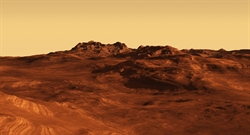‘Planet Four: Craters’ recruits citizen scientists to help age the surface of Mars, and experiment with interface design
Adler Planetarium and the University of Nottingham collaborate on a new web-based platform that engages the public in scientific research through image analysis
On March 26th 2015 the Adler Planetarium and the University of Nottingham launched ‘Planet Four: Craters’, a new web-based citizen science initiative that provides an opportunity for members of the public to actively participate in planetary research. The platform is available at craters.planetfour.org.
Planet Four: Craters is a product of a two-year collaboration between Adler Planetarium’s Zooniverse team and the University of Nottingham’s Horizon Centre for Doctoral Training. To help scientists age the surface of the planet Mars, in order to inform future missions to the plane
 t, a citizen science platform has been created that empowers the public to assist researchers. Participants are asked to mark craters found in the latest satellite imagery of the Martian surface.
t, a citizen science platform has been created that empowers the public to assist researchers. Participants are asked to mark craters found in the latest satellite imagery of the Martian surface.
Visitors to the site will use one of several different interface designs, and will be able to give their thoughts and opinions on the pros and cons of each through an online questionnaire. It is hoped that this feedback will help improve the design of future versions of Planet Four, and many other Citizen Science projects.
The Zooniverse, a project led by the Adler Planetarium and the University of Oxford, is the world’s leading – and largest – citizen science platform, which has engaged more than 1 million online volunteers as active scientists on more than 30 science projects.
How Planet Four: Craters Works
From a user perspective, Planet Four: Craters is clean, simple and easy. Users are taken to one of the interfaces, shown a satellite image of the Martian surface, and asked to mark the outline of any craters they can spot using a set of drawing tools supplied. At any point during their time on the site they can click on a link to the online questionnaire to share their thoughts and opinions to help make future Zooniverse projects easier to use.
By knowing the size and number of craters on an area of the Martian surface, scientists can work out its age. Assuming a brand new surface has zero craters, and estimating the rate at which impact craters are formed over time, they can work out how long it has taken for the number of marked craters found by the public to appear, and therefore determine the age of the surface.
“Planet Four: Craters is exciting because it not only allows members of the public to directly contribute to planetary research in a very real way, but also lets them tell us what they like and dislike about the interface, so that we can improve their experience in the future” said James Sprinks, PhD candidate at Horizon and Lead of the Planet Four: Craters project.
“With public participation in this research, not only can anyone actively contribute to science, but hopefully they may learn a little bit about the planet Mars, and get to see amazing images of the surface in the process!”
Visit craters.planetfour.org to participate in the research or learn more.
For further information, contact:
James Spinks, Horizon CDT & Nottingham Geospatial Institute, University of Nottingham. James.sprinks@nottingham.ac.uk














